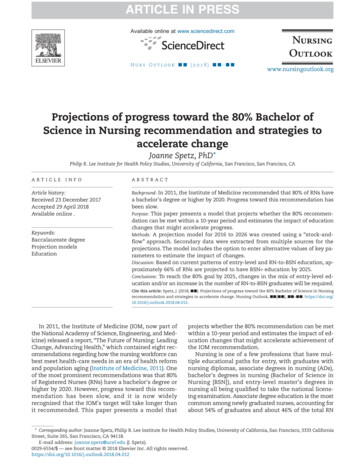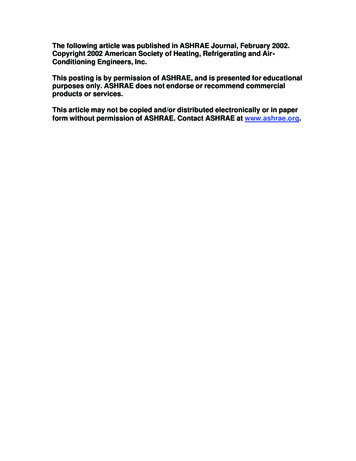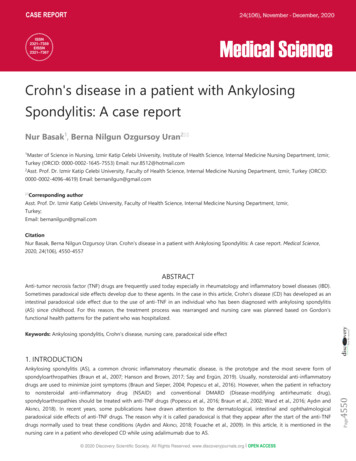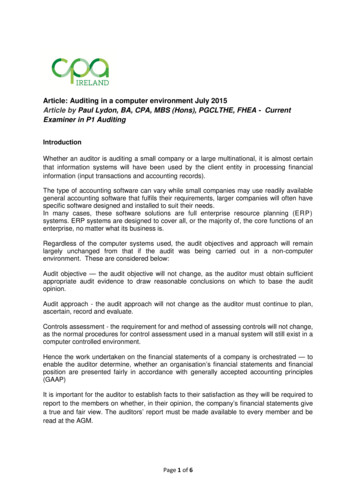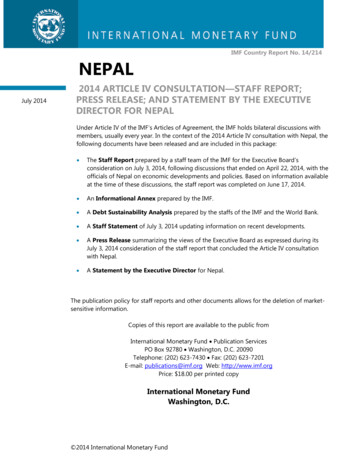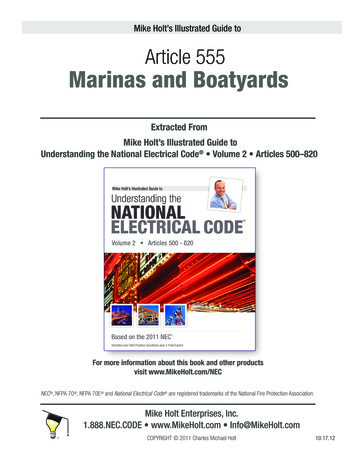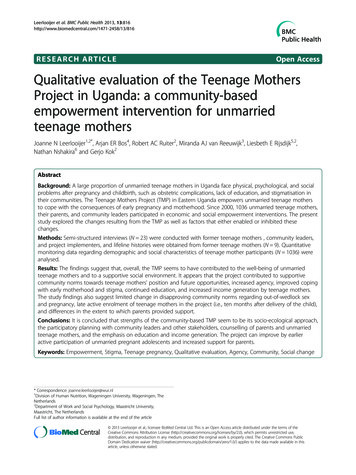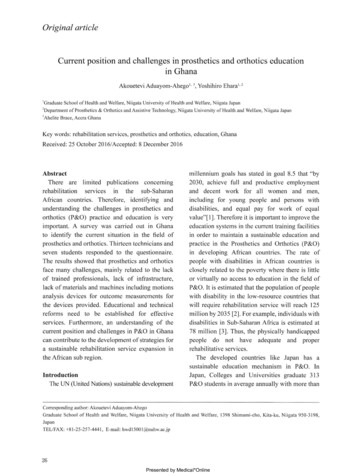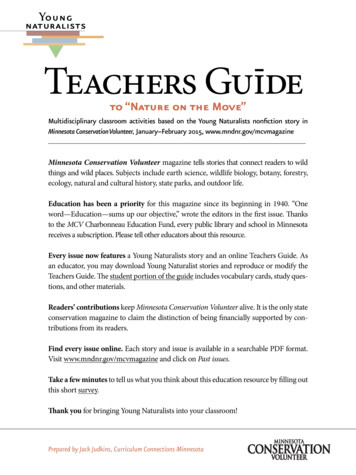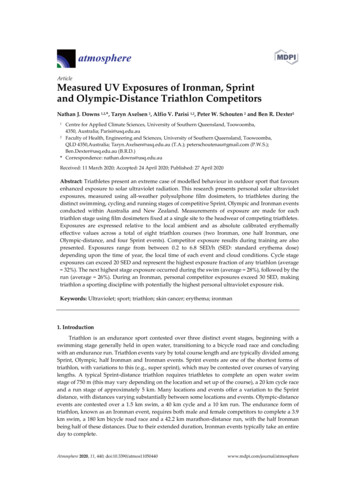
Transcription
ArticleMeasured UV Exposures of Ironman, Sprintand Olympic-Distance Triathlon CompetitorsNathan J. Downs 1,2,*, Taryn Axelsen 2, Alfio V. Parisi 1,2, Peter W. Schouten 2 and Ben R. Dexter21Centre for Applied Climate Sciences, University of Southern Queensland, Toowoomba,4350, Australia; Parisi@usq.edu.au2 Faculty of Health, Engineering and Sciences, University of Southern Queensland, Toowoomba,QLD 4350,Australia; Taryn.Axelsen@usq.edu.au (T.A.); peterschoutenau@gmail.com (P.W.S.);Ben.Dexter@usq.edu.au (B.R.D.)* Correspondence: nathan.downs@usq.edu.auReceived: 11 March 2020; Accepted: 24 April 2020; Published: 27 April 2020Abstract: Triathletes present an extreme case of modelled behaviour in outdoor sport that favoursenhanced exposure to solar ultraviolet radiation. This research presents personal solar ultravioletexposures, measured using all-weather polysulphone film dosimeters, to triathletes during thedistinct swimming, cycling and running stages of competitive Sprint, Olympic and Ironman eventsconducted within Australia and New Zealand. Measurements of exposure are made for eachtriathlon stage using film dosimeters fixed at a single site to the headwear of competing triathletes.Exposures are expressed relative to the local ambient and as absolute calibrated erythemallyeffective values across a total of eight triathlon courses (two Ironman, one half Ironman, oneOlympic-distance, and four Sprint events). Competitor exposure results during training are alsopresented. Exposures range from between 0.2 to 6.8 SED/h (SED: standard erythema dose)depending upon the time of year, the local time of each event and cloud conditions. Cycle stageexposures can exceed 20 SED and represent the highest exposure fraction of any triathlon (average 32%). The next highest stage exposure occurred during the swim (average 28%), followed by therun (average 26%). During an Ironman, personal competitor exposures exceed 30 SED, makingtriathlon a sporting discipline with potentially the highest personal ultraviolet exposure risk.Keywords: Ultraviolet; sport; triathlon; skin cancer; erythema; ironman1. IntroductionTriathlon is an endurance sport contested over three distinct event stages, beginning with aswimming stage generally held in open water, transitioning to a bicycle road race and concludingwith an endurance run. Triathlon events vary by total course length and are typically divided amongSprint, Olympic, half Ironman and Ironman events. Sprint events are one of the shortest forms oftriathlon, with variations to this (e.g., super sprint), which may be contested over courses of varyinglengths. A typical Sprint-distance triathlon requires triathletes to complete an open water swimstage of 750 m (this may vary depending on the location and set up of the course), a 20 km cycle raceand a run stage of approximately 5 km. Many locations and events offer a variation to the Sprintdistance, with distances varying substantially between some locations and events. Olympic-distanceevents are contested over a 1.5 km swim, a 40 km cycle and a 10 km run. The endurance form oftriathlon, known as an Ironman event, requires both male and female competitors to complete a 3.9km swim, a 180 km bicycle road race and a 42.2 km marathon-distance run, with the half Ironmanbeing half of these distances. Due to their extended duration, Ironman events typically take an entireday to complete.Atmosphere 2020, 11, 440; sphere
Atmosphere 2020, 11, 4402 of 15Wearable polymer film, biological spore and electronic dosimeters have been appliedsuccessfully to measure solar UV exposures incident on amateur and professional sportspeopleacross a range of disciplines and environments [1–3]. Unlike instrumentation such as radiometersthat may be fixed and mounted to a specific site, personal dosimeters offer a lightweight,cost-effective and convenient measurement tool able to record an exposure over an extendedinterval of time that can be attached to a location on the body without interrupting the physicalmobility of the study subject. Table 1 presents a range of studies completed over the past twentyyears that have used personal dosimeters to measure solar ultraviolet (UV) exposure on participantsengaged in outdoor sports and associated training activities. Sports such as skiing, golfing andcycling have been investigated extensively. However, there is currently limited data available on UVexposures measured for triathletes. It is likely that the necessity of the triathlete to transitionbetween different event stages causes difficulty in measuring accurate personal exposures. Thisparticular difficulty may be of greatest significance as the triathlete transitions from the swim to thecycle stage of an event as any dosimeters that need to be used must be water proof, and be easilyexchanged by the competitor during the transition without the loss of time.To date the only exposure study that has investigated the sport of triathlon was conducted byMoehrle [4]. Moehrle [4] reported the average erythemally effective solar UV exposure receivedexclusively during the combined bicycle and run stages for the Hawaii Ironman (worldchampionships) of three competitive triathletes. Averaging an erythemally effective event exposureof 20.8 SED (2080 Jm 2), these exposures, which were measured only during the cycle and run stageof the Ironman, represent the highest documented personal biologically effective sun exposurerecorded in a single day for a competitive sport. This is likely to be a concern for elite and age-groupathletes competing in day-long Ironman events. However, given the Ironman distance representsonly one category of a sport increasing in popularity worldwide, this research seeks to examine thepotential influence of the different categories of triathlon during each of the swim, cycle and runstages of an event, the effect of event timing, the effect of event location and the possible influence oftraining on the elective UV exposure risks triathletes face when competing.
Atmosphere 2020, 11, yclingSkiingCyclingSkiingMountaineeringIronman TriathlonActivity/SportTypeSerrano et al. [10]Downs et al. [14]Serrano et al. [12]Thieden et al. [13]Serrano et al. [10]Serrano et al. [11]Serrano et al, [11]Serrano et al. [10]Moehrle [8]Rigel et al. [9]Serrano et al. [7]Casale et al. [6]Moehrle et al. [5]Moehrle [4]Author7.62 4.28 SED over five training days2.1 SED daily (range of 0.71 to 4.9 SED)0.7 SED to 3.7 SED daily3.2 SED vertex exposures in summer to 0.2 SED(forearm) in winter per round10.65 1.57 SED over two days of training in summer7.5 SED daily in summer8.1 SED daily in summer9.48 3.23 SED daily in summer32.24 4.14 SED in summer and 11.30 5.36 in winterover two days16.2 SED daily in summer1 SED to 15.2 SED daily6.7 SED to 21.3 SED (9:00 am to 1:00 pm)20.8 SED (range of 17.3 SED to 24.3 SED) over theevent duration (cycle and run only)6.6 SED daily (range of 0.6 to 24.2 SED)Solar UV ExposureEvent schedule;Ambient UVAltitude; AlbedoAltitude; Albedo;Ambient UVImportant Factors3 of 15Table 1. A summary of recent studies demonstrating the variation in personal exposure measured using dosimeters across a range of outdoor sports. (SED: standarderythema dose).RunningGurrea Ysasi et al.[15]Serrano et al. [11]2.07 SED in head position and 1.62 SED in wristposition during winter per round2 SED daily in summer0.093 SED approximately 4 hours early morning(range of 0.062 to 0.136 SED)Exposure time;TimingSeason; ExposuretimeAmbient UV; TimingExposure time;TimingSeason; TimingAmbient UVAltitude; AlbedoExposure time;TimingAltitude; AmbientUV; TimingAmbient UV; TimingExposure time;TimingAlbedo; Ambient UVIndividual behaviorSeasonRunningNurse et al. [16]GolfRunning
Atmosphere 2020, 11, 4404 of 152. Materials and MethodsMeasurements of personal solar UV exposure for the sport of triathlon were made over threeindividual training sessions and eight competitive triathlon events contested within Australia andNew Zealand between November 2017 and December 2018. Events were contested over Sprint,Olympic, half Ironman and Ironman distances. Triathlon sites included three suburbs of Brisbane(27.5 S 153.0 E): Bribie Island (27.0 S, 153.1 E), Raby Bay (27.5 S, 153.3 E), and Springfield (27.7 S, 152.9 E); four event sites located within Queensland, New South Wales and Western Australia:Mooloolaba (26.7 S 153.1 E), Robina (28.1 S 153.4 E), Byron Bay (28.6 S, 153.6 E), and Busselton(33.7 S, 115.3 E); and one site located in New Zealand: Taupo (37.7 E 176.1 E). The location, eventtype, local starting time of each triathlon stage and event date are listed in Table 2. Minimum andmaximum temperature recorded in the 24-hour period of each event [17,18] and MODIS Terra cloudfraction expressed in octa (eighths) [19] are also listed in Table 2. Event locations are shown in Figure1.Table 2. Scheduled participant triathlon events listed by event category in the period 2017 to 2018.EventLocationDateBribieIsland(Qld-Aus)27.0 S153.1 ERaby Bay(Qld-Aus)27.5 S153.3 ERobina(Qld-Aus)28.1 S153.4 E14 January2018OlympicTaupo(NZ)38.7 E176.1 E3 March2018IronmanBribieIsland(Qld-Aus)27.0 S153.1 E25 March2018SprintByron Bay(NSW-Aus)28.6 S153.6 E12 May2018SprintMooloolaba(Qld-Aus)26.7 S153.1 E26 August2018Half-IronmanBusselton(WA-Aus)33.7 S115.3 imCycleRunSwimCycleRunSwimCycleRun1 km29 km7.5 km0.9 km25 km5.6 km1.5 km40 km10 km3.8 km180 km42.2 km0.75 km20 km5 km0.75 km20 km5 km1.9 km90 km21 km3.8 km180 km*21.3 kmLocalStart7:30 am7:50 am8:46 am7:55 am8:17 am9:08 am7:00 am7:33 am8:45 am6:15 am7:30 am1:18 pm7:30 am7:44 am8:24 am12:20 pm12:40 pm1:24 pm6:17 am6:54 am9:35 am6:46 am7:57 am1:23 pmTemperature(min/max)CloudFraction18.3/29.0 C5 octa18.9/27.5 C5 octa34.4/24.7 C2 octa15/22 C8 octa17.6/26.1 C8 octa11.4/20.1 C0 octa15.2/20.8 C2 octa12.4/26.8 C7 octa*Injury during the Busselton Ironman prevented the participant from completing a 42.2 km run.Event training was also monitored for a single study participant. Periods of personal trainingfor triathlon events including environment conditions on the date of training [17–19] are provided inTable 3. Training for the study participant took place in Springfield (Queensland). The total timespent outdoors while training for each triathlon stage is listed in Table 3 and was determined by thetriathlete. Unlike the events listed in Table 2, the time spent outside while training is not dependenton a specified course length. Event training took place between 29 October and 13 November 2017.
Atmosphere 2020, 11, 4405 of 15Table 3. Scheduled triathlete training periods in 2017.EventLocationSpringfield(Qld-Aus)27.7 S152.9 ESpringfield(Qld-Aus)Springfield(Qld-Aus)27.7 S152.9 E27.7 S152.9 eRunSwimExposureTime3h 42 min39 min52 mLocalStart6:16 am10:19 am2:11 pmTrainingCycleRun5 h 18 min37 minTrainingSwim1 h 37 tion20.7/31.5 C2 octa5:52 am11:36 am11.9/25.7 C8 octa8:59 am13.4/26.0 C7 octaFigure 1. Triathlon event locations. Springfield and Raby Bay are suburbs of the greater Brisbanearea. North is at top and scale is approximately 35 x 50 .Polysulphone (PS) dosimeters manufactured from thin film strips with an approximatethickness of 40 microns were distributed as badges to all study participants. PS film dosimeters areuseable in all weather conditions [20] and were chosen for this application in triathlon to also enablemeasurement of exposure during the swimming stage of each scheduled event. These badge-typedosimeters (Figure 2), when mounted to a flexible polymer frame (15 10 mm) are lightweight andhave a clear circular aperture of 6 mm covered by PS, which undergoes a change in absorbance at330 nm as a result of exposure to UV radiation.(a)(b)(c)(d)Figure 2. Polysulphone film dosimeters used in this study were adhered to small flexible framesnotably smaller than badges used in similar studies (a), that were pinned to the swimming cap (b),bicycle helmet (c) and cap (d) of each participant.The change in absorbance, , was measured as the difference in PS film absorbance at 330nm pre- and post-exposure at four sites and averaged across each PS dosimeter. The average
Atmosphere 2020, 11, 4406 of 15of a set of eight dosimeters was calibrated to a field radiometer maintained as part of the AustralianRadiation and Nuclear Safety Authority (ARPANSA) national UV radiation monitoring network[21]. The radiometer, located in Brisbane, measures the cumulative erythemally effective [22] solarUV in J m-2. To calibrate the PS badges, the of the calibration dosimeters was plotted againstthe cumulative UV exposure measured during a midmorning calibration interval in the Brisbanearea. A single A4 sheet of PS film was used to cast all dosimeters used in the study. For the eightdosimeters used in the calibration the average PS film absorbance measured pre-exposure (n 32)was 0.136 9% ( 1 s.d). Here, PS film post-exposure measurements were made several days afterthe calibration to minimize post-exposure differences caused by the dark reaction of PS film. Thisreaction results in a change in optical absorbance of around 4% 24 hours following an exposurewhich stabilizes thereafter [23]. The calibration was performed on 18 February 2018 (late summer inthe southern hemisphere).Figure 3 shows the calibration curve of the PS film used for the personal UV badges distributedin this study. The practical limit of dosimeters calibrated to this curve for field exposure during atriathlon event enabled personal measurements of exposure up to approximately 15 SED, where 1SED is the equivalent of 100 Jm 2 erythemally effective UV [22].
A typical Sprint-distance triathlon requires triathletes to complete an open water swim stage of 750 m (this may vary depending on the location and set up of the course), a 20 km cycle race and a run stage of approximately 5 km. Many locations and events offer a variation to the Sprint distance, with distances varying substantially between some locations and events. Olympic-distance events are .


